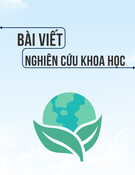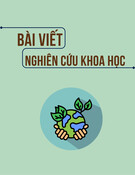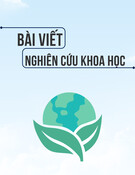
HPU2. Nat. Sci. Tech. Vol 03, issue 03 (2024), 52-59.
HPU2 Journal of Sciences:
Natural Sciences and Technology
Journal homepage: https://sj.hpu2.edu.vn
Article type: Research article
Received date: 16-9-2024 ; Revised date: 08-10-2024 ; Accepted date: 05-11-2024
This is licensed under the CC BY-NC 4.0
52
Some data about endangered and rare plant species in Me Linh Station
for Biodiversity, Vinh Phuc province
Thuy-Diu Tran
a,b
, Thi-Nga Tran
a,c
, Thi-Phuong Dong
a,d
*
,Thanh-Hoa Mai
e
, Minh-Tam Ha
a
a
Hanoi Pedagogical University 2, Vinh Phuc, Vietnam
b
Vietnam Russia Vocational Training College 1, Vinh Phuc, Vietnam
c
Tran Nguyen Han Secondary School, Bac Giang, Vietnam
d
Luong The Vinh High School, Hanoi, Vietnam
e
Tay Bac University, Son La, Vietnam
Abstract
Me Linh Station for Biodiversity has an area of 170.3 hectares, near Tam Dao National Park.
Although the area is not large, it has with high biodiversity and rich flora, including many rare and
threatened plant species. So, this place not only preserves biodiversity but also organizes research and
educational activities to protect biodiversity and the environment. Some research projects have been
done on species diversity, ecosystem diversity, and forest biomass... This study identifies 38
endangered and rare plant species. Among them, 20 species in Vietnam Red Data Book 2007; 20
species belong to Decree No. 84/2021/ND-CP; 16 species belong to Appendix II of CITES (2024), and
4 species belong to IUCN (2024). Simultaneously, this study added summary information about the
conservation status, life forms, geographical factors, and uses of 38 plant endangered and rare species
in Me Linh Station for Biodiversity, Vinh Phuc province.
Keywords: Endangered plant, rare plant, life forms, geographical factors, uses, Me Linh Station for
Biodiversity
1. Introduction
Me Linh Station for Biodiversity has an area of 170.3 hectares, near Tam Dao National Park. This
place not only preserves biodiversity but also organizes research and educational activities to protect
biodiversity and the environment. According to statistics, the flora here currently has 852 plant
*
Corresponding author, E-mail: dongphuong291299@gmail.com
https://doi.org/10.56764/hpu2.jos.2024.3.3.52-59

HPU2. Nat. Sci. Tech. 2024, 3(3), 52-59
https://sj.hpu2.edu.vn 53
species, which are endangered and rare. These plant species play an essential role in nature and are of
great value to humans, requiring in-depth research and updating their current status. Up to now, there
has been some of research on species diversity. A study by S. C. Kim, N. V. Sinh, and D. V. Hai
describes some of the typical plant species in this area, including some endangered and rare plant
species [1]. D. V. Hai, N. T. Cuong, R. K. Choudhary, Z. Lin, and Y. Deng discovered and announced
Cosmianthemum melinhense - a new species from the Me Linh Station for Biodiversity [2]. However,
in-depth research on endangered and rare plant species has not been mentioned. Therefore, we have
research endangered and rare plant species here to provide a database to protect biodiversity and the
environment.
2. Research methods
To research endangered and rare species in Me Linh Station for Biodiversity, we used a method
described by N. N. Thin in references [3] and [4]. This method is based on the characteristics of plant
organs, especially the reproductive organs.
2.1. Study area and sample collection
The study area was in Me Linh Station for Biodiversity; data collection was carried out during
field trips to sample, photograph, observe, and to record the characteristics of specimens in their living
state, observing their distribution, habitat, and other characteristic.
2.2. Classification
Specimens were analyzed from whole to detail, from outside to inside where the analysis was
combined with the description. Then, the monographs were used to classify. The species names were
identified by using a comparative morphological method based on P. H. Ho's works [5]–[7] and Flora
of Vietnam [8]–[11]. The nomenclature of species was accorded to Flora of Vietnam and Checklist of
plant species of Vietnam [12]–[14]; the species names were updated according to The Plant list [15].
2.3. Conservation status assessment
The conservation status assessment was based on the classification of the Vietnam Red Book part
II – Plants [16], Decree no. 03/VBHN-BTNMT [17], Decree no. 84/2021/ND-CP [18], CITES [19],
and IUCN [20].
2.4. Life form and geographical element classification
Life forms (biological spectrum) were based on the division scale of Raunkiær [21], geographical
factors [22], and plant resources in T. M. Hoi's work [23].
3. Results and discussion
3.1. Conservation value of plant species in the Me Linh Station for Biodiversity
We have been determined 38 endangered and rare plant species in Me Linh Station for
Biodiversity, Table 1. In Table 1, the life form was denoted base on the Raunkiaer's work [21]. Ph
(Phanerophytes) includes Mg (Megaphanerophytes: over 30 meters high), Me (Mesophanerphytes:
from 8 to 30 meters high), Mi (Microphanerophytes: from 2 to 8 meters high), and Na
(Nanaphanerophytes: from 0.5 to 2 meters high). Some abbreviations including Ch (Chamerophytes),
Hm (Hemicryptophytes), Cr (Cryptophytes), Ep (Epiphytes phanerophytes), and Lp (Lianes
phanerophytes).

HPU2. Nat. Sci. Tech. 2024, 3(3), 52-59
https://sj.hpu2.edu.vn 54
Table 1. Comprehensive checklist of endangered and rare plant species in Me Linh Station for Biodiversity
TT Science names Vietnam
names
Life
form
Geographical
element Uses
Conservation value
National
International
Red
data
book
Decree
84 IUCN
CITES
POLYPODIOPHYTA
1. Cyatheaceae
1.
Cyathea gigantea
(Wall. ex Hook)
Holttum
Ráng gỗ
nhăn Mi 19 Or, M IIA Pl.II
2. Dicksoniaceae
2.
Cibotium barometz
(L.) J. Sm.
Lông cu
li
Ch 29 Or, M IIA Pl.II
3. Polypodiaceae
3.
Drynaria bonii Chr. Cốt toái
b
ổ
Ep 18 M VU IIA
MAGNOLIOPHYTA
DICOTYLEDONEAE
4. Anacardiaceae
4.
Gluta laccifera (Pierre)
Ding Hou
Sơn huyết Mg 17 W, L VU
5.
Annonace
ae
5.
Goniothalamus
takhtajanii
Ban
Giác đế
tam đ
ả
o
Mi 16 W CR
6.
Apocynaceae
6.
Rauvolfia verticillata
(Lour.) Baill.
Ba gạc
vòng
Mi 17 M VU
7.
Aristolochiaceae
7.
Asarum glabrum
Merr.
Hoa tiên
Hm
17
M
VU
8.
Burs
eraceae
8.
Canarium pimela K.
D. Koenig
Trám đen Me 18 W, F,
M
VU
9. Campanulaceae
9.
Codonopsis javanica
(Blume) Hook. f.
Đẳng sâm Lp 33 M VU IIA
10. Fabaceae
10.
Dalbergia assamica
Benth.
Cọ khẹt Me 17 W, M Pl.II
11.
Dalbergia rimosa
Roxb.
Trắc dây Lp 21 M IIA Pl.II
11.
Fagaceae
12.
Castanopsis ferox
(Roxb.) Spach
Dẻ gai Me 17 W VU
13.
Castanopsis tessellata
Hick. & A. Cam.
Cà ổi lá
đa
Me 17 W VU
12. Lauraceae
14.
Cinnadenia paniculata
(Hook.f.)Kosterm.
Kháo
xanh
Me 33 W, E VU VU
13.
Menispermaceae
15.
Stephania dielsiana Y.
C. Wu
Củ dòm Lp 18 M VU IIA
16.
Stephania longa
Lour.
Lư
ỡ
i ti
ề
n
Ch
17
M
IIA
17.
Stephania rotunda
Lour.
Bình vôi Cr 21 M IIA
18.
Tinospora sagittata
(Oliv.) Gagnep.
Củ gió Ch 13 M VU

HPU2. Nat. Sci. Tech. 2024, 3(3), 52-59
https://sj.hpu2.edu.vn 55
TT Science names Vietnam
names
Life
form
Geographical
element Uses
Conservation value
National
International
Red
data
book
Decree
84 IUCN
CITES
14. Myrsinaceae
19.
Ardisia
silvestris
Pit.
Lá khôi
Hm
16
M
VU
20.
Embelia parviflora
Wall. ex A. DC.
Thiên lý
hương
Ch 25 M VU
15.
Opiliaceae
21.
Melientha suavis
Pierre
Rau s
ắ
ng
Mi
17
V
VU
16.
Sa
potaceae
22.
Madhuca pasquieri
(Dubard) H. J. Lam
Sến mật Mg 13 W,
Oil, M
VU EN
17. Schisandraceae
23.
Kadsura coccinea
(Lem.) A. C. Smith
Nắm cơm Lp 17 M IIA
18.
Thymelaeaceae
24.
Aquilaria crassna
Pierre ex Lecomte
Trầm
hương
Mi 17 W, M,
E
EN CR Pl.II
19. Tiliaceae
25.
Colona poilanei
Gagnep.
Cọ mai
nháp lá
nh
ỏ
Me 13 W NT
MONOTYLEDONEAE
20.
Convallariaceae
26.
Disporopsis longifolia
Craib.
Hoàng
tinh hoa
Cr 21 M VU IIA
21.
Asparagaceae
27.
Peliosanthes teta
Andr.
Sâm cau
Cr
21
M
VU
IIA
22.
Orchidaceae
28.
Anoectochilus
brevilabris
Lindl.
Giải thùy
ba răng
Cr 18 Or, M EN IA Pl. II
29.
Bulbophyllum
concinnum
Hook. f.
Cầu diệp
xinh
Hm 21 Or IIA Pl. II
30.
Bulbophyllum fischeri
Seidenf.
Long
gamble
Hm 21 Or IIA Pl. II
31.
Dendrobium nobile
Lindl.
Thạch
h
ộ
c
Ep 25 Or, M IIA Pl. II
32.
Epipogium roseum (D.
Don) Lindl.
Thượng
lan
Cr 17 Or IIA Pl. II
33.
Geodorum densiflorum
(Lamk.) Schlecht.
Địa kim
hoa dày
Cr 21 Or IIA Pl. II
34.
Goodyera foliosa
(Lindl.) Benth. ex C.
B. Clarke
Hảo lan
lá Cr 21 Or IIA Pl. II
35.
Tainia viridifusca
(Hook.) Benth.
Tài lan
xanh nâu
Cr 13 Or, M IIA Pl. II
36.
Thrixspermum
centipeda
Lour.
Bạch
đi
ể
m
Ep 23 Or IIA Pl. II
37.
Thrixspermum
formosanum (Hayata)
Schlecht.
Mao tử
đài loan Ep 33 Or IIA Pl. II
38.
Trichotosia pulvinata
(Lindl.) Kraenzl.
Mao lan
g
ố
i
Ep 21 Or IIA Pl. II
Also, in Table 1, the geographical element was numbered based on L. T. Chan's work [22] as
follows:

HPU2. Nat. Sci. Tech. 2024, 3(3), 52-59
https://sj.hpu2.edu.vn 56
13. Bacbo endemic
16. Vietnam endemic
17. Indochina endemic
18. Southern China endemic
19. Hainam, Taiwan, Philippines element
21. India element
23. Indonesia, Malaysia element
25. Topical Asia element
29. Asia element
33. Unknown element
CR (Critically Endangered), EN (Endangered), VU (Vulnerable), and NT (Near Threatened) were
marked based on Vietnam Red Data Book [16] and IUCN [20].
In Table 1, column Decree 84, IA and IIA notes are correspond to the appendixes of the
Governments Decree No. 84/2021/ND-CP [17]. Appendix IA lists species threatened with extinction,
prohibited from export, import, re-export, introduction from the sea and transit of natural specimens
for commercial purposes. Appendix IIA lists species that, although currently not threatened with
extinction, may become so without control of export, import, re-export, introduction from the sea and
transit of natural specimens thereof for commercial purposes. In the CITIES column, the notations
were based on CITES [19], in which Appendix I lists species threatened with extinction, prohibited
from export, import, re-export, introduction from the sea, and transit of natural specimens for
commercial purposes and Appendix II lists species that, although currently not threatened with
extinction, may become so without control of export, import, re-export, introduction from the sea and
transit of natural specimens thereof for commercial purposes. The “Uses” column was based on T. M.
Hoi's work [13] with following notations: F (Fruit), Or (ornamental plant), Oil (fatty oils), W (woods),
L (latex), E (essentials), M (medicines), and V (vegetable) respectively.
Table 1 shows that 38 endangered and rare plant species belong to 2 phyla, 22 families in Me
Linh Station for Biodiversity. Among them, Magnoliophyta accounts for the majority with 19 families
(accounting for 86.36%), 35 species (accounting for 92.1%); in there, 22 species belong to the
Magnoliopsida (accounting for 57,89% of the total number of species), and 13 species belong to the
Liliopsida (accounting for 34.21% of the total number of species); Polypodiophyta has three species
belong to 3 families (Table 2).
Table 2. Distribution of taxa in phyla
Phyla Family Genus Species
Quantity
Rate (%)
Quantity
Rate (%)
Quantity
Rate (%)
POLYPODIOPHYTA
3
13.64
3
3
MAGNOLIOPHYTA
19
86.36
29
90.63
35
92.1
Magnoliopsida
16
18
22
57,89
Liliopsida
3
13.64
11
34.76
13
43.21
Total 22 100 32 100 38 100
The family with the most species is Orchidaceae, with 11 species (accounting for 28.95% of the
total number of species); next is the Menispermaceae with 4 species (accounting for 10.53% of the
total number of species); Fabaceae, Fagaceae and Myrsinaceae, each family has 2 species (accounting

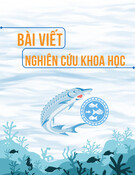



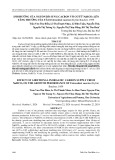
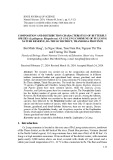
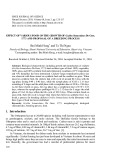
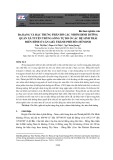
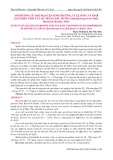
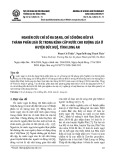
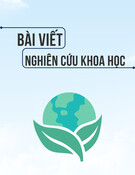
![Tài liệu Vi sinh vật môi trường [Mới nhất]](https://cdn.tailieu.vn/images/document/thumbnail/2025/20251123/ngkimxuyen/135x160/21891763953413.jpg)
![Sổ tay truyền thông Phân loại chất thải rắn sinh hoạt trên địa bàn tỉnh Quảng Nam [Chuẩn nhất]](https://cdn.tailieu.vn/images/document/thumbnail/2025/20251114/kimphuong1001/135x160/1701763094001.jpg)
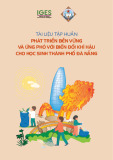
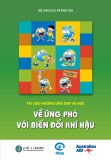
![Quản lý chất thải nguy hại: Sổ tay Môi trường [Chuẩn nhất]](https://cdn.tailieu.vn/images/document/thumbnail/2025/20251029/kimphuong1001/135x160/9011761720170.jpg)




